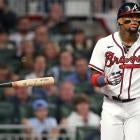Full disclosure: I own most every one of these pitchers in some league or another.
It's sort of the state of the game right now. With offense continuing to rise across the majors, the trend at starting pitcher is for higher impact over shorter spurts, which doesn't make for the greatest of Fantasy assets even when the skills are there.
There isn't a single league where I couldn't use another starting pitcher, and in such an environment, Fantasy players can only be so discerning when assessing the flavor of the week — or month or whatever length of time we're talking here. There's a certain validity, then, to making a claim in the hope that something sticks, and even the least of these has filled that need for me.
My point being that this exercise is less about adding and dropping and more about understanding what your level investment should be, whether in making a trade or considering who to drop for that next flavor of the week.
I've short-handed the process somewhat by assigning each of these players a rating on my legitimacy scale, which ranges from "confident" to "hopeful" to "skeptical" to "doubtful." Hint: Only the "doubtfuls" are the ones I could seriously consider dropping at this point — and even that's not an across-the-board standard.
Understand that when discussing the legitimacy of these pitchers, it's less about the exact numbers and more about the likelihood they'll remain an integral part of your pitching staff all year. Kind of goes without saying Zach Davies won't sustain 1.54 ERA.
With nary a hiccup in his eight starts so far, Matthew Boyd almost feels too obvious for this list, but the fact is he was scarcely drafted and, at 28, had offered few signs of this sort of potential prior to this year. Remember how Patrick Corbin rated heading into last year? It wasn't quite as low as Boyd this year, but nobody imagined him doing what he ultimately did. Boyd has gone about it the same way, making his slider the focal point of his arsenal, and has enjoyed a similar rise in swinging strike rate. He's had some home run luck, which explains why his FIP is more than half a point lower than his ERA, but ... holy cow, his FIP is more than half a point lower than his ERA.
Legitimacy scale: confident
Zach Davies' success has relied on a similar trick — he's doubling down on his best pitch, the changeup, at the expense of everything else — but unlike Boyd's slider, it's not a great swing-and-miss offering. His 6.0 K/9 is fifth-worst among qualifiers, in fact. He has genuinely allowed weak contact, which is why is xwOBA is mostly in line with his wOBA, but there's a reason his xFIP and SIERA both project an ERA close to 5.00: In an era defined by hard contact, too much contact almost always leads to ruin. The recent examples of pitchers who've managed the tight-rope walk Davies is attempting are few and far between and almost all extreme ground-ball pitchers, like Miles Mikolas last year. Davies, at least this year's version, is closer to neutral in that regard.
Legitimacy scale: doubtful
Zach Eflin isn't far ahead of Davies in K/9, his 6.7 representing a big drop from last year, but I give him a leg up because his control has been on another level. His 1.2 BB/9 would have led the majors last year, and it's that pinpoint command that's allowed him to spot his cutter so well, leading to the sort of weak contact that gives him an xwOBA in line with his wOBA. So great, he's been as good as he should be based quality of contact so far. But when quality of contact is that much of an outlier, it's too fine of a line to walk all season, which is why I trust the predictive powers of SIERA (4.22) and xFIP (4.39) more. Again, I give Eflin a chance because his control is so good and he has some swing-and-miss in his past, but he seems like a definite sell-high guy.
Legitimacy scale: skeptical
Granted, things looked better for Max Fried two starts ago, when he was still sporting a 2.11 ERA. But then, I guess it's a matter of perspective, isn't it? What I saw then was a two-pitch pitcher who didn't miss enough bats to continue at his pace. What I've seen since is the introduction of a third pitch, a slider, which has added some deception to his arsenal and proven to be a good swing-and-miss offering in its own right. It's not the reason for his recent slide either. For one thing, he hasn't thrown it that much, and for another, hitters entered Sunday batting .063 against it.
Legitimacy scale: hopeful
As the most available pitcher on this list, Lucas Giolito is absolutely someone I'm making a play for after his latest outing Sunday in which he allowed one run on four hits with one walk and eight strikeouts over seven innings. It followed a start Tuesday in which he struck out eight over 7 1/3 shutout innings. His swinging strike rate has spiked this year thanks to a slight uptick in velocity and a greatly improved secondary arsenal, most notably the breaking ball. But the former Nationals prospect has faked us out in the past. The walk rate remains high, and there wasn't as much reason for optimism just a couple starts ago. An earlier IL stint means he hasn't gotten as many chances as most other pitchers yet, and I'd like to see a little more before fully buying in.
Legitimacy scale: skeptical
The changes in Mike Minor's approach aren't as obvious as the impact they've had. His swinging strike rate is now much closer to his dominant year in relief with the Royals — when he put together a 2.55 ERA, 1.02 WHIP and 10.2 strikeouts per nine innings — and he's getting ground balls at a similar rate, too, which makes him less susceptible to the most dangerous forms of contact. He has always been a good enough control pitcher, and the Rangers clearly aren't afraid to let him go a third time through the order when the pitch count allows, seeing as he has already thrown seven-plus innings five times. Just having that sort of leash is a valuable attribute — and dare I say an underrated one — in today's game.
Legitimacy scale: hopeful
I was one of Frankie Montas' loudest detractors early on, pointing out that his new splitter hadn't really improved his strikeout or swinging strike rates from a year ago when he also got off to a great start before crashing hard. But now, after delivering his three best swinging-strike efforts in his past four starts, he's up to 8.3 K/9. His splitter has a 20 percent whiff rate, which is good for any pitch, and has also contributed to his elite ground-ball rate. The walks are down, too, for good measure, so that's improvement on all three legs of the FIP triangle and a big thumbs up from me.
Legitimacy scale: hopeful
If you want to make a case for Jake Odorizzi, it's that his average fastball velocity is up about a mile per hour from last year, making it technically the hardest he's ever thrown, which is notable because his fastball is the pitch doing all the damage, generating whiffs at an uncommon rate. But a high-whiff fastball has always been his modus operandi. What hasn't been is keeping the ball in the yard, which makes it surprising he has served up only two home runs so far, especially since he has the second-highest fly-ball rate among qualifying pitchers. Oh look, his xFIP and SIERA both suggest his ERA should be over 4.00.
Legitimacy scale: doubtful
Part of what makes me want to buy into Martin Perez is that his changes are so drastic. He tweaked his delivery to add 2 mph to his fastball, making him one of the hardest throwers in baseball, and went from not having a cutter to throwing one 35 percent of the time. And egad, the league is batting only .100 against it. So clearly, he's a different pitcher now than the one who floundered for all those years in Texas, and it's also reflected in the strikeout and swinging strike rates, which are both respectable. Are they good enough to justify what he's doing now? If the cutter remains that good, maybe, but the xFIP and SIERA (both 4.38) aren't so convinced.
Legitimacy scale: skeptical
I don't know what there'd be to doubt about Caleb Smith now except whatever biases you bring to the discussion. Yes, he's a 27-year-old who didn't follow the traditional path to greatness, and yes, acknowledging him means acknowledging that Derek Jeter and company actually made a good trade (having acquired him from the Yankees). But his high-rpm fastball makes it one of the best at generating swings and misses, and his curveball and changeup have both proven to be elite bat-missers as well. In fact, he has the top swinging strike rate among qualifiers this year, ahead of Gerrit Cole. He was doing similar things before suffering a lat injury last June but now has improved his control and efficiency.
Legitimacy scale: confident
When Spencer Turnbull began making waves this spring, I noticed his 10.0 K/9 in the minors last year and thought he might be a sneaky sleeper. I backed away when he had a 4.80 ERA after three starts only to watch him take off from there. While the strikeout rate hasn't been as good as I dreamed it might be, it's been good enough for someone who limits hard contact, and having two breaking balls that generate whiffs suggests rooms for growth. Walks and workload are concerns, though.
Legitimacy scale: skeptical
Recognizing last year that his fastball and changeup alone weren't enough to take him where he wanted to go, Luke Weaver tried introducing a curveball. But he couldn't find consistency with it and too often found himself working from behind in the count, where he couldn't play the fastball and changeup against each other as well. His newest addition, a cutter, has not only proven to be a better swing-and-miss offering than the curveball, but it has him seeing more 0-2 and fewer 3-0 counts than a year ago, when he was below league average in both.
Legitimacy scale: hopeful











































